FORD CONTOUR 1998 2.G Manual PDF
Manufacturer: FORD, Model Year: 1998, Model line: CONTOUR, Model: FORD CONTOUR 1998 2.GPages: 200, PDF Size: 2.7 MB
Page 71 of 200
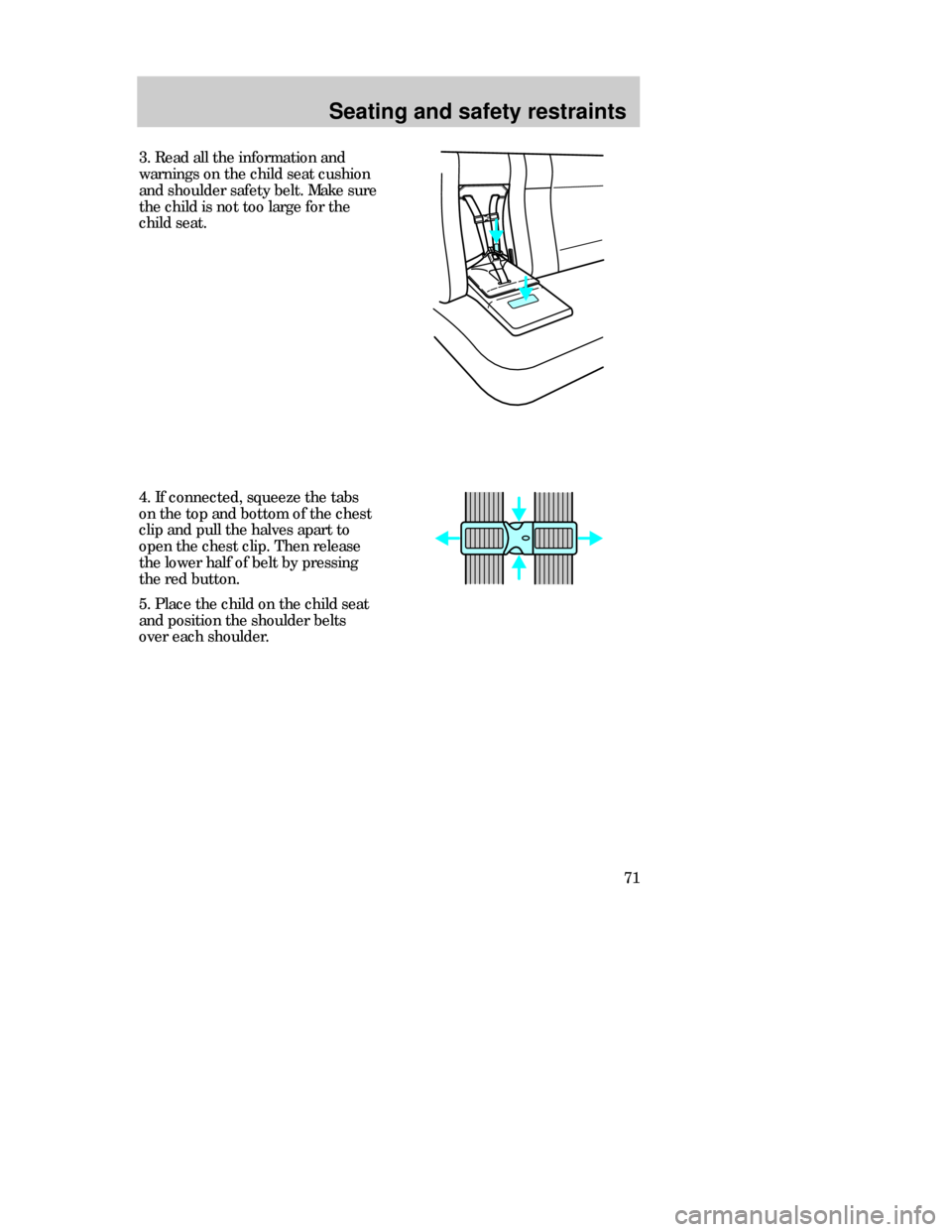
Seating and safety restraints
71
4. If connected, squeeze the tabs
on the top and bottom of the chest
clip and pull the halves apart to
open the chest clip. Then release
the lower half of belt by pressing
the red button.
5. Place the child on the child seat
and position the shoulder belts
over each shoulder. 3. Read all the information and
warnings on the child seat cushion
and shoulder safety belt. Make sure
the child is not too large for the
child seat.
CDW IIID Seat en C 5/15/97 8:48 PM Page 71
Page 72 of 200
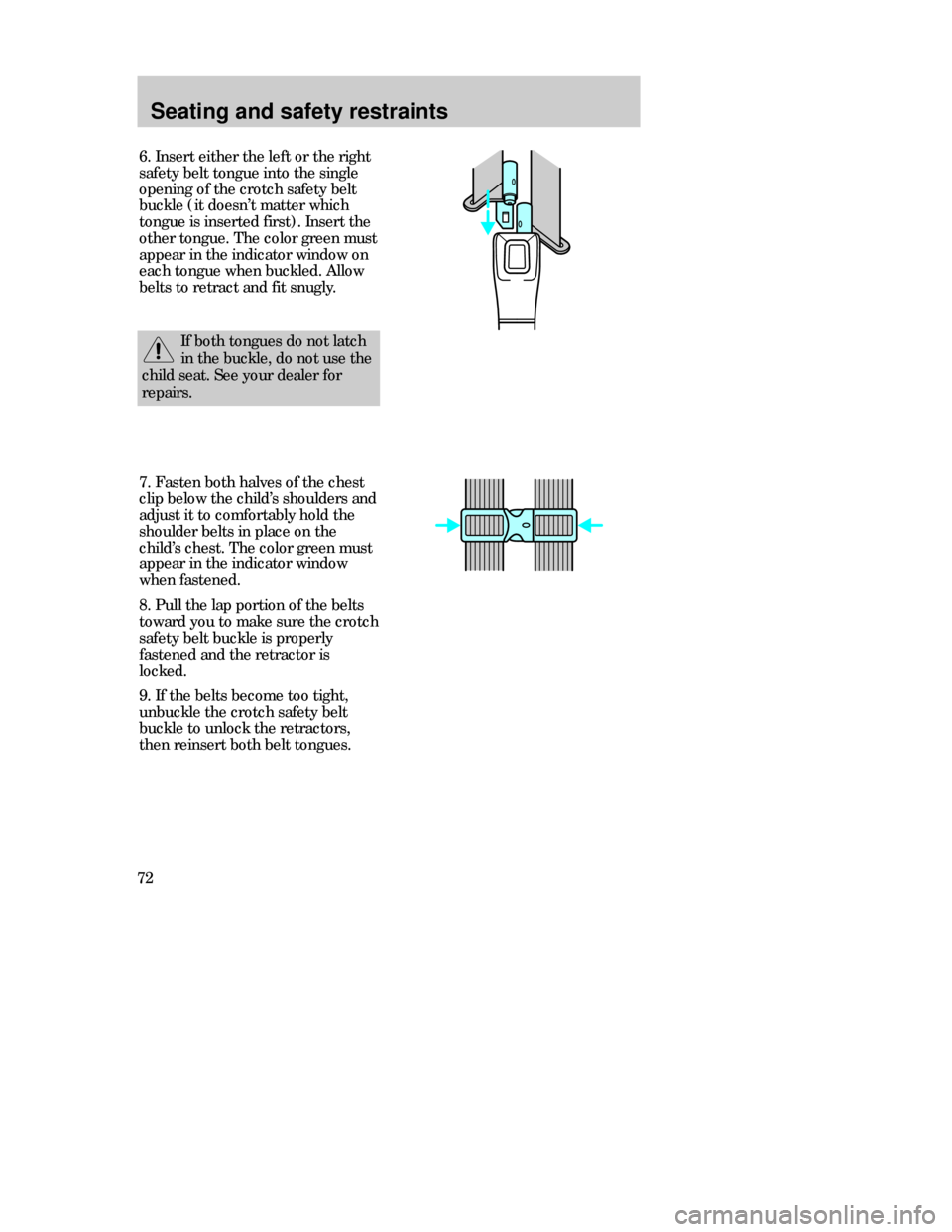
Seating and safety restraints
72
7. Fasten both halves of the chest
clip below the child’s shoulders and
adjust it to comfortably hold the
shoulder belts in place on the
child’s chest. The color green must
appear in the indicator window
when fastened.
8. Pull the lap portion of the belts
toward you to make sure the crotch
safety belt buckle is properly
fastened and the retractor is
locked.
9. If the belts become too tight,
unbuckle the crotch safety belt
buckle to unlock the retractors,
then reinsert both belt tongues.
If both tongues do not latch
in the buckle, do not use the
child seat. See your dealer for
repairs.
6. Insert either the left or the right
safety belt tongue into the single
opening of the crotch safety belt
buckle (it doesn’t matter which
tongue is inserted first). Insert the
other tongue. The color green must
appear in the indicator window on
each tongue when buckled. Allow
belts to retract and fit snugly.
CDW IIID Seat en C 5/15/97 8:48 PM Page 72
Page 73 of 200
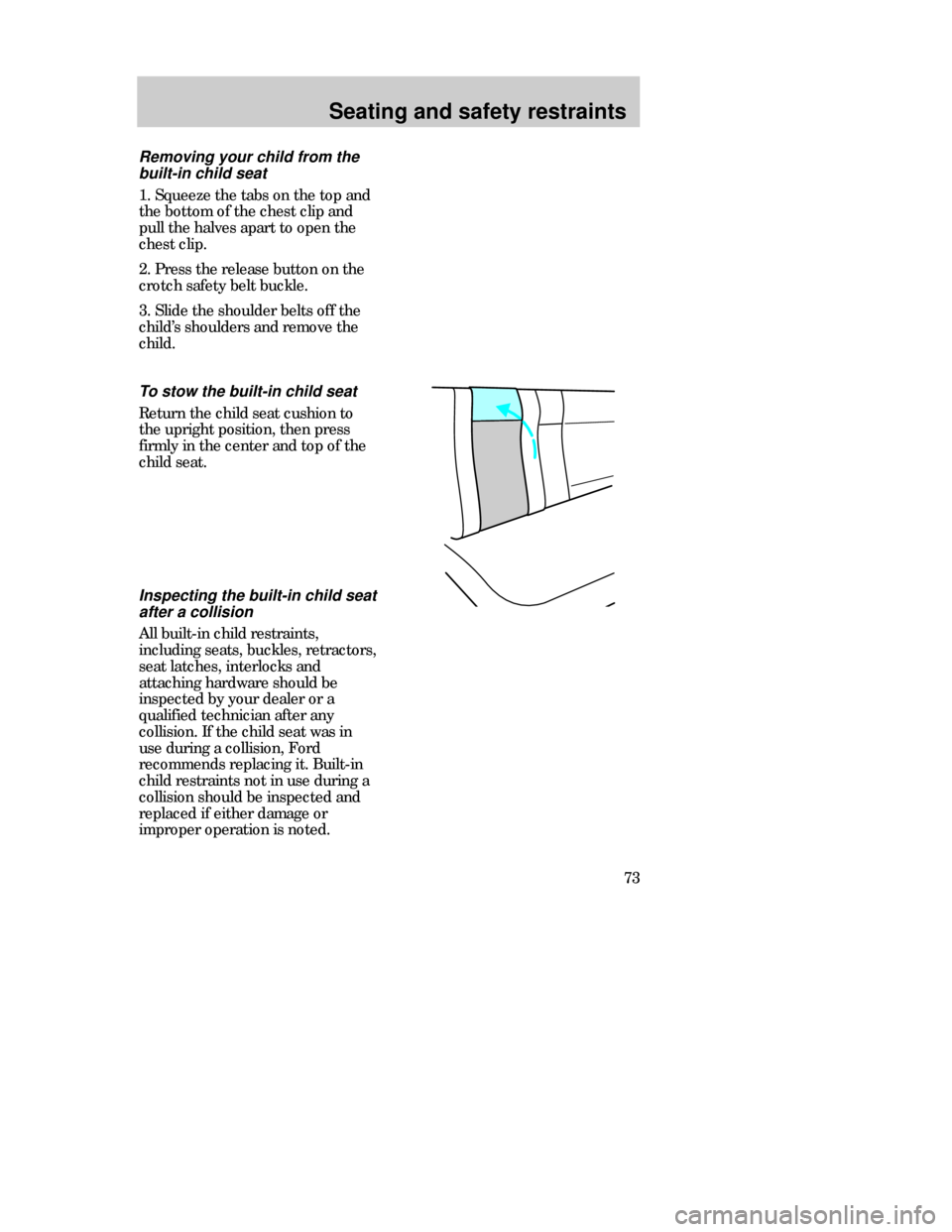
Seating and safety restraints
73
To stow the built-in child seat
Return the child seat cushion to
the upright position, then press
firmly in the center and top of the
child seat.
Removing your child from the
built-in child seat
1. Squeeze the tabs on the top and
the bottom of the chest clip and
pull the halves apart to open the
chest clip.
2. Press the release button on the
crotch safety belt buckle.
3. Slide the shoulder belts off the
child’s shoulders and remove the
child.
Inspecting the built-in child seat
after a collision
All built-in child restraints,
including seats, buckles, retractors,
seat latches, interlocks and
attaching hardware should be
inspected by your dealer or a
qualified technician after any
collision. If the child seat was in
use during a collision, Ford
recommends replacing it. Built-in
child restraints not in use during a
collision should be inspected and
replaced if either damage or
improper operation is noted.
CDW IIID Seat en C 5/15/97 8:48 PM Page 73
Page 74 of 200
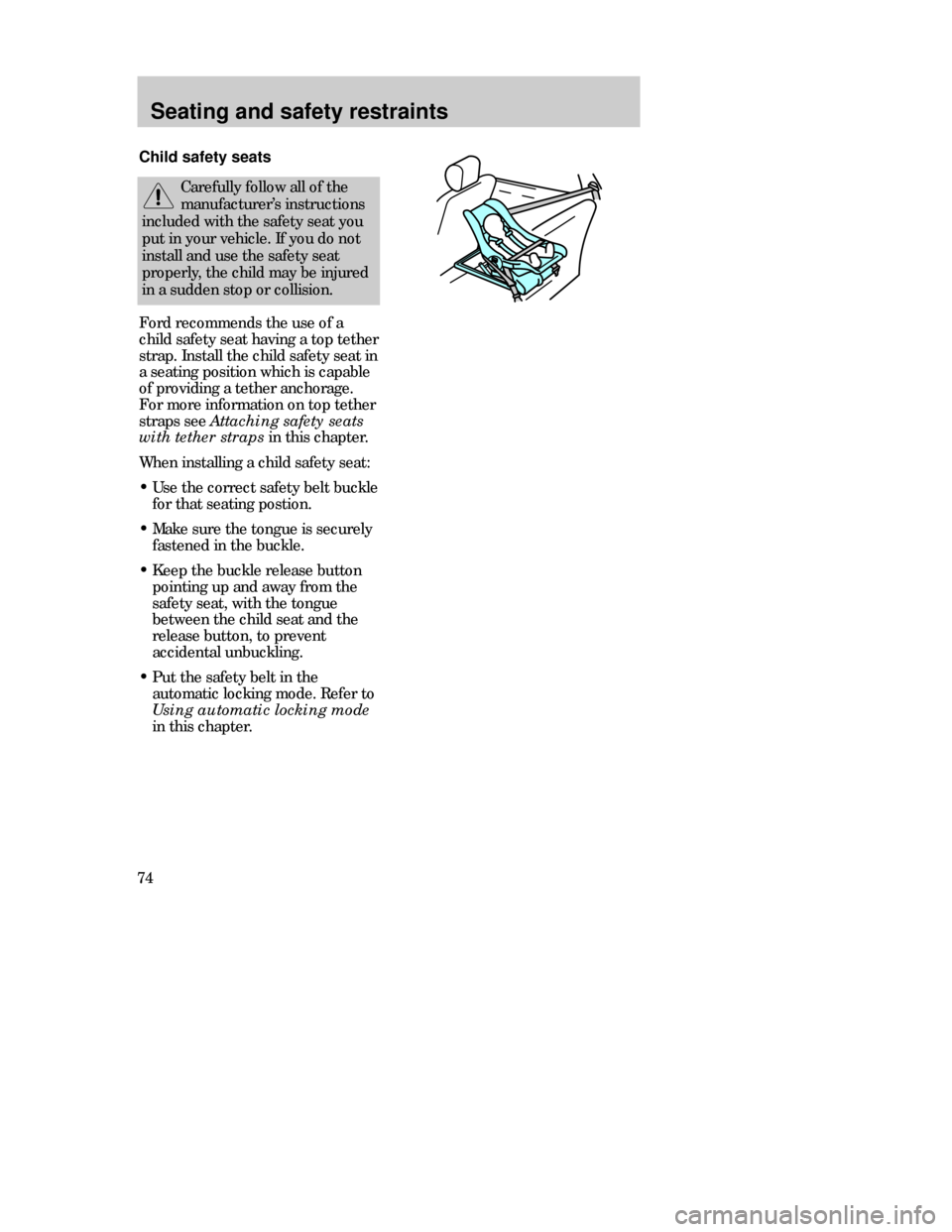
Seating and safety restraints
74
Carefully follow all of the
manufacturer’s instructions
included with the safety seat you
put in your vehicle. If you do not
install and use the safety seat
properly, the child may be injured
in a sudden stop or collision.
Ford recommends the use of a
child safety seat having a top tether
strap. Install the child safety seat in
a seating position which is capable
of providing a tether anchorage.
For more information on top tether
straps see Attaching safety seats
with tether strapsin this chapter.
When installing a child safety seat:
•Use the correct safety belt buckle
for that seating postion.
•Make sure the tongue is securely
fastened in the buckle.
•Keep the buckle release button
pointing up and away from the
safety seat, with the tongue
between the child seat and the
release button, to prevent
accidental unbuckling.
•Put the safety belt in the
automatic locking mode. Refer to
Using automatic locking mode
in this chapter. Child safety seats
CDW IIID Seat en C 5/15/97 8:48 PM Page 74
Page 75 of 200
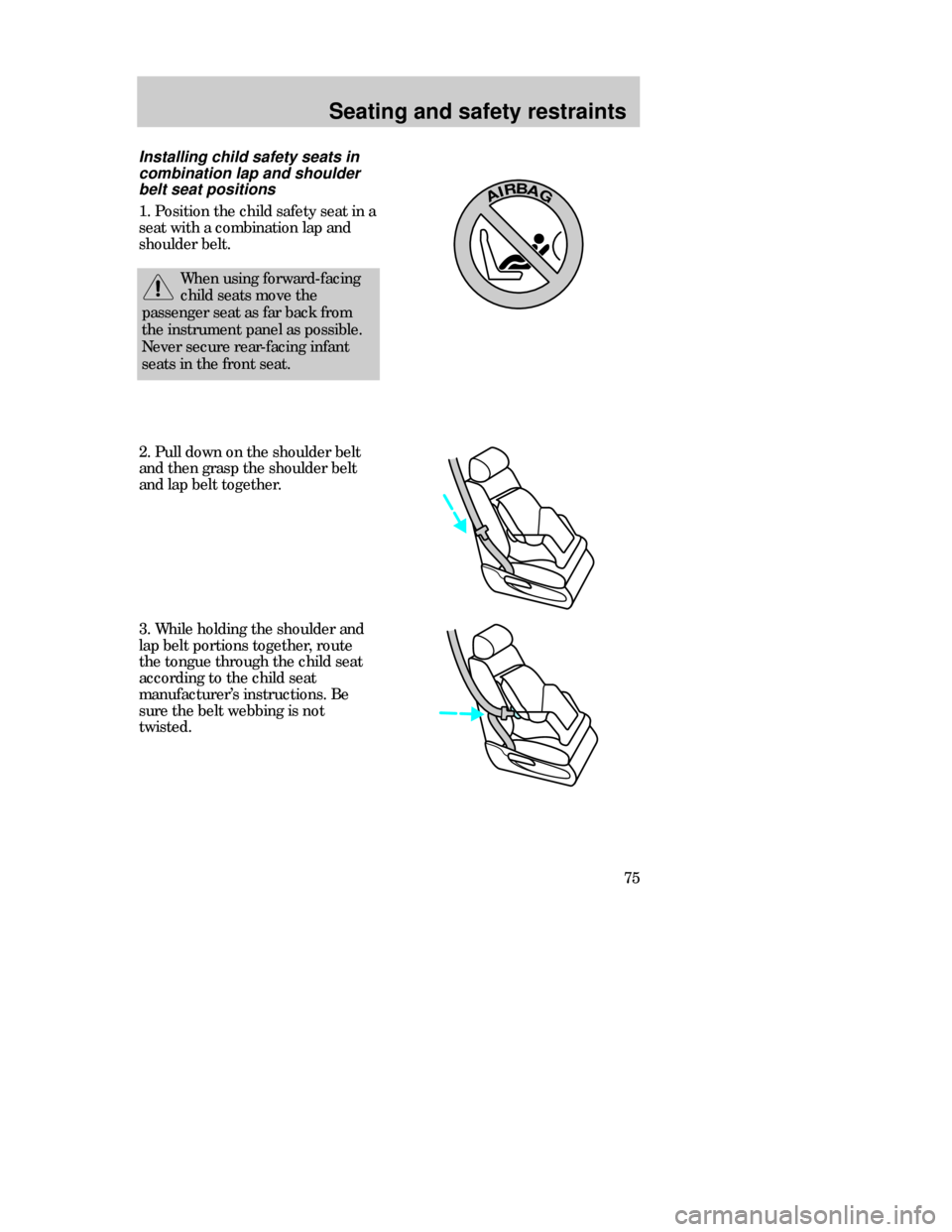
Seating and safety restraints
75
2. Pull down on the shoulder belt
and then grasp the shoulder belt
and lap belt together.
3. While holding the shoulder and
lap belt portions together, route
the tongue through the child seat
according to the child seat
manufacturer’s instructions. Be
sure the belt webbing is not
twisted.
AIRBAG
Installing child safety seats in
combination lap and shoulder
belt seat positions
1. Position the child safety seat in a
seat with a combination lap and
shoulder belt.
When using forward-facing
child seats move the
passenger seat as far back from
the instrument panel as possible.
Never secure rear-facing infant
seats in the front seat.
CDW IIID Seat en C 5/15/97 8:48 PM Page 75
Page 76 of 200
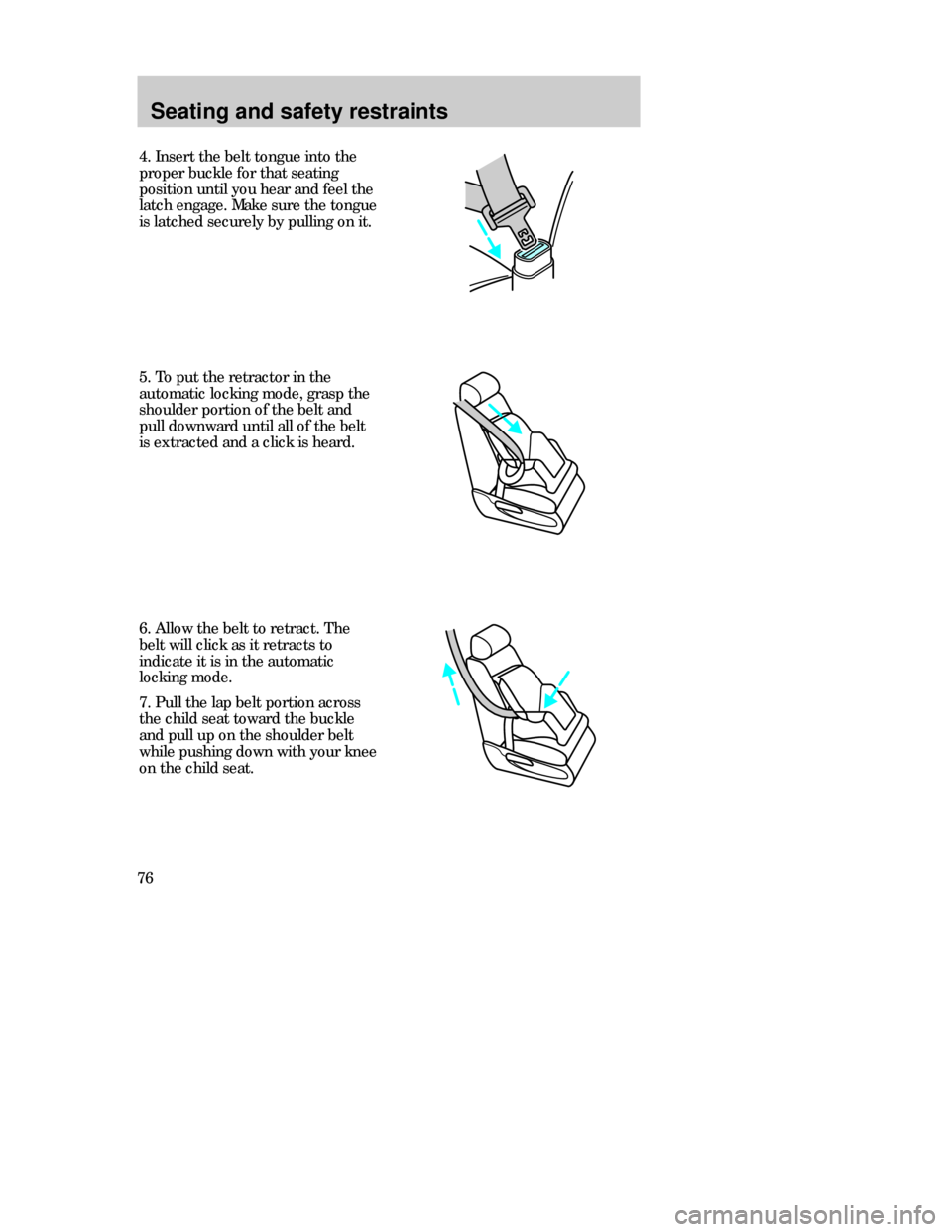
Seating and safety restraints
765. To put the retractor in the
automatic locking mode, grasp the
shoulder portion of the belt and
pull downward until all of the belt
is extracted and a click is heard.
4. Insert the belt tongue into the
proper buckle for that seating
position until you hear and feel the
latch engage. Make sure the tongue
is latched securely by pulling on it.
6. Allow the belt to retract. The
belt will click as it retracts to
indicate it is in the automatic
locking mode.
7. Pull the lap belt portion across
the child seat toward the buckle
and pull up on the shoulder belt
while pushing down with your knee
on the child seat.
CDW IIID Seat en C 5/15/97 8:48 PM Page 76
Page 77 of 200
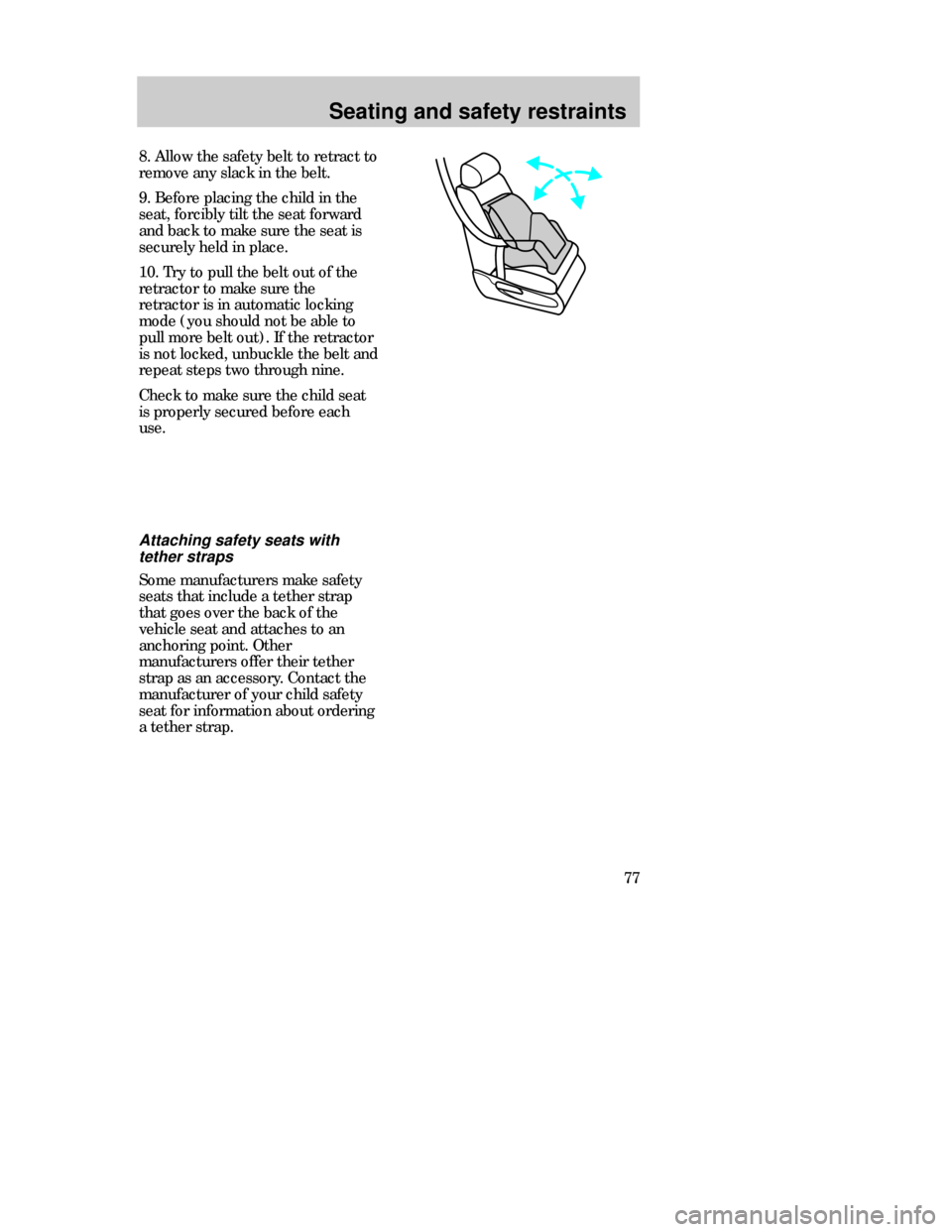
Seating and safety restraints
77 8. Allow the safety belt to retract to
remove any slack in the belt.
9. Before placing the child in the
seat, forcibly tilt the seat forward
and back to make sure the seat is
securely held in place.
10. Try to pull the belt out of the
retractor to make sure the
retractor is in automatic locking
mode (you should not be able to
pull more belt out). If the retractor
is not locked, unbuckle the belt and
repeat steps two through nine.
Check to make sure the child seat
is properly secured before each
use.
Attaching safety seats with
tether straps
Some manufacturers make safety
seats that include a tether strap
that goes over the back of the
vehicle seat and attaches to an
anchoring point. Other
manufacturers offer their tether
strap as an accessory. Contact the
manufacturer of your child safety
seat for information about ordering
a tether strap.
CDW IIID Seat en C 5/15/97 8:48 PM Page 77
Page 78 of 200
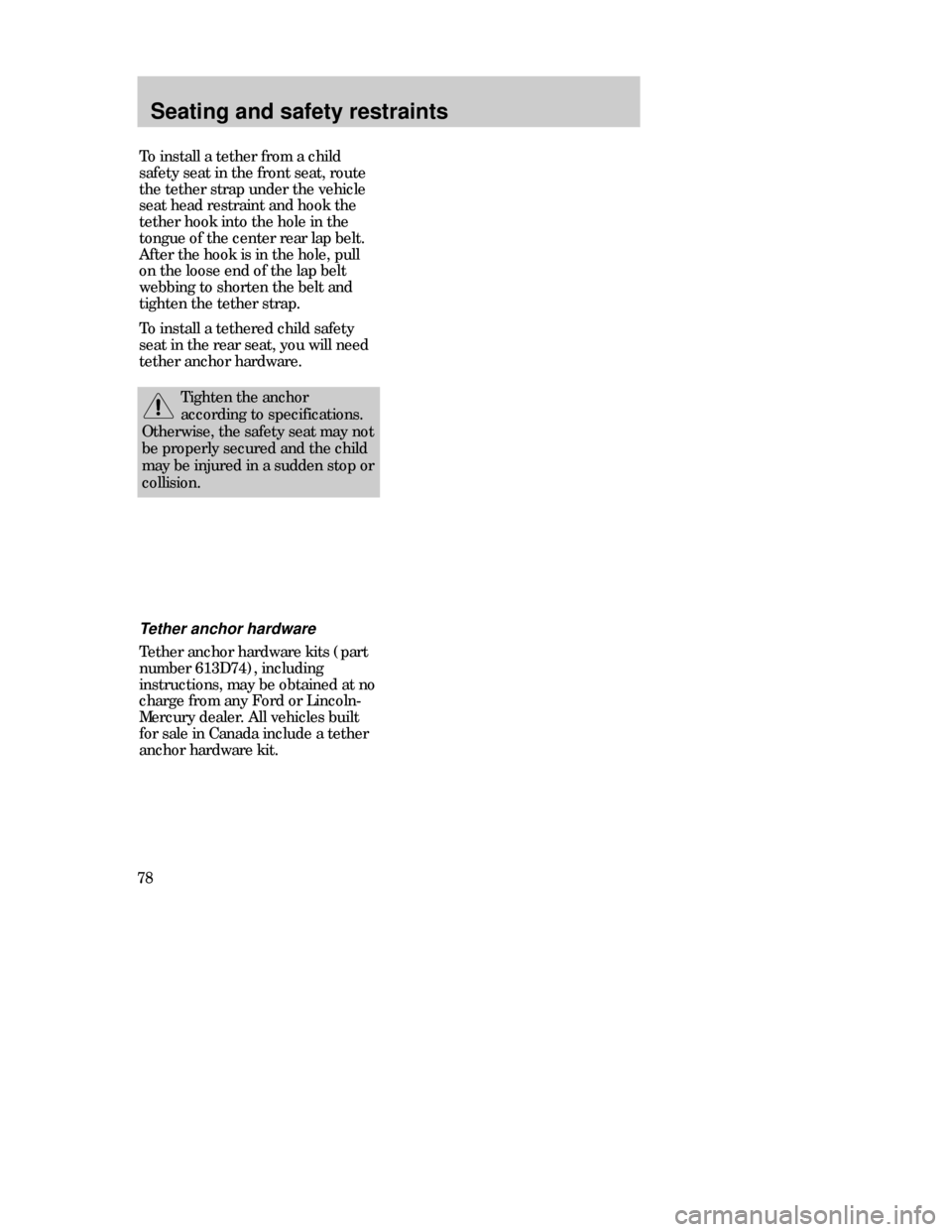
Seating and safety restraints
78To install a tether from a child
safety seat in the front seat, route
the tether strap under the vehicle
seat head restraint and hook the
tether hook into the hole in the
tongue of the center rear lap belt.
After the hook is in the hole, pull
on the loose end of the lap belt
webbing to shorten the belt and
tighten the tether strap.
To install a tethered child safety
seat in the rear seat, you will need
tether anchor hardware.
Tether anchor hardware
Tether anchor hardware kits (part
number 613D74), including
instructions, may be obtained at no
charge from any Ford or Lincoln-
Mercury dealer. All vehicles built
for sale in Canada include a tether
anchor hardware kit.
Tighten the anchor
according to specifications.
Otherwise, the safety seat may not
be properly secured and the child
may be injured in a sudden stop or
collision.
CDW IIID Seat en C 5/15/97 8:48 PM Page 78
Page 79 of 200
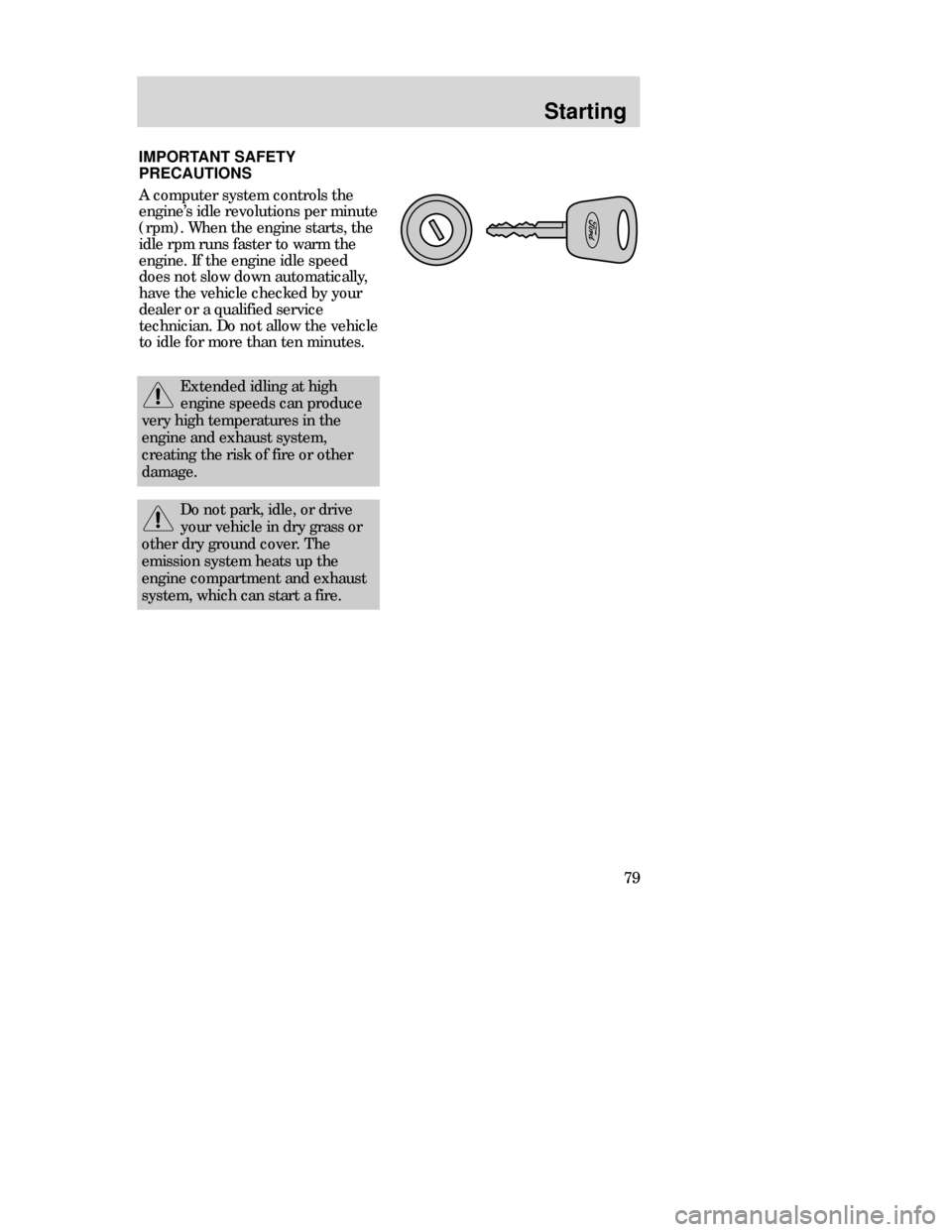
79
Starting
Extended idling at high
engine speeds can produce
very high temperatures in the
engine and exhaust system,
creating the risk of fire or other
damage.
IMPORTANT SAFETY
PRECAUTIONS
A computer system controls the
engine’s idle revolutions per minute
(rpm). When the engine starts, the
idle rpm runs faster to warm the
engine. If the engine idle speed
does not slow down automatically,
have the vehicle checked by your
dealer or a qualified service
technician. Do not allow the vehicle
to idle for more than ten minutes.
Do not park, idle, or drive
your vehicle in dry grass or
other dry ground cover. The
emission system heats up the
engine compartment and exhaust
system, which can start a fire.
CDW IIID Seat en C 5/15/97 8:48 PM Page 79
Page 80 of 200
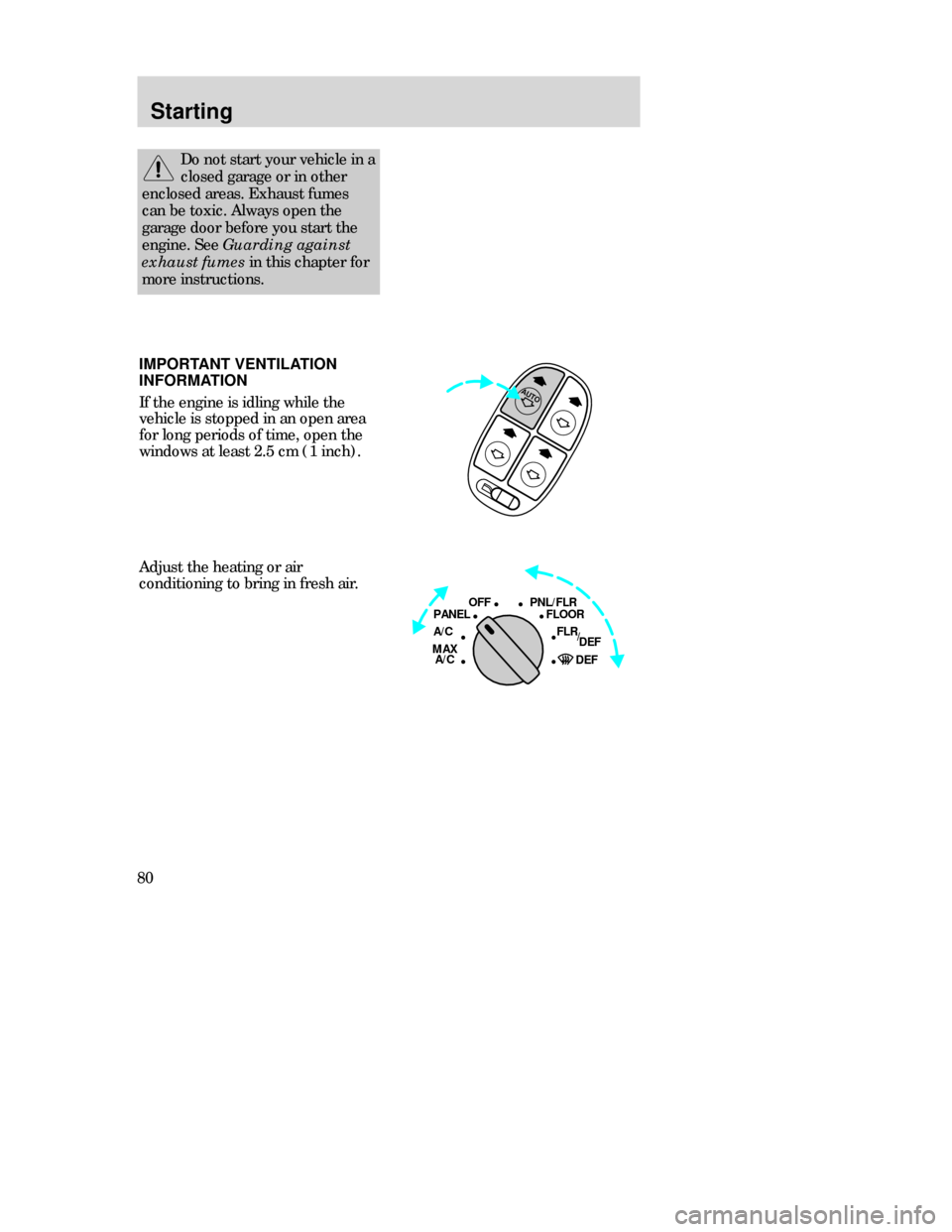
Starting
80IMPORTANT VENTILATION
INFORMATION
If the engine is idling while the
vehicle is stopped in an open area
for long periods of time, open the
windows at least 2.5 cm (1 inch).
AUTO
OFFPNL/FLR
PANEL
A/CFLOOR
DEF FLR
DEF
MAX
A/C/
Adjust the heating or air
conditioning to bring in fresh air.
Do not start your vehicle in a
closed garage or in other
enclosed areas. Exhaust fumes
can be toxic. Always open the
garage door before you start the
engine. See
Guarding against
exhaust fumesin this chapter for
more instructions.
CDW IVA1_2 Starting en C 5/15/97 8:50 PM Page 80